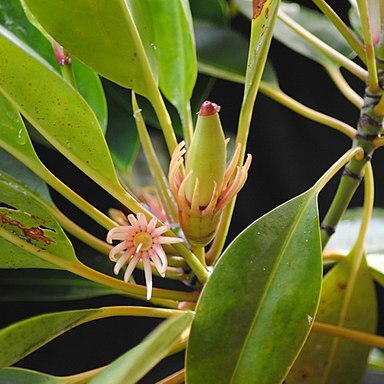Tree to 20 m high, often buttressed; bark light brown to grey. Leaves elliptic or oblong-elliptic, acute; lamina 8–16 cm long, 3–6 cm wide, flat; petiole usually reflexed, 1.5–5 cm long; stipules 3.5–4 cm long, green or yellow-green. Flowers solitary, c. 3 cm long at anthesis; pedicels 6–12 mm long. Hypanthium c. 1.5 cm long, distinctly ribbed throughout. Sepals 10–12, linear, yellow to rusty brown. Petals c. 1.5 cm long, 2-lobed, pubescent at base and usually along margins; tips of lobes reflexed; bristles 1 in sinus and often 1 or more on each lobe near but scarcely exceeding tip. Anthers 4–5 mm long, without mucro. Hypocotyl 6–12 cm long, 1.5–2 cm wide, somewhat angular, narrowed at both ends.
Trees 6-8(-15) m tall, d.b.h. 15-35 cm. Bark gray to pale brown, smooth. Stipules green or yellowish, 3.5-4 cm. Petiole yellowish, 1.5-3.5 cm; leaf blade elliptic, elliptic-oblong, or rarely oblanceolate, 8-13(-16) × 3-6 cm, base cuneate to rarely obtuse, apex acute. Pedicel 6-12 mm. Flowers solitary, yellow, 2.7-4 cm. Calyx tube 1-1.5 cm; lobes 9-13, ca. 2 cm. Petals 1-1.5 cm, margin with a tuft of hairs, apex 2-lobed; lobes obtuse, with 1 or 2 short bristles less than 1.5 mm, bristles not exceeding lobes. Stamens 0.7-1.4 cm. Style 1.5-2.2 cm, apical branches to 0.5 mm. Fruit 1.5-1.8 cm. Fruiting calyx tube ± distinctly ribbed. Hypocotyl cigar-shaped, ± angular, 6-8 cm. Fl. autumn, fr. spring.
A medium sized erect tree. It grows to 40 m high. The trunk is 80 cm across. The bark is grey. The bark is thick, ridged and very dark and contains a few large brown corky spots. The leaves are pointed at the tip and wedge shaped at the base. The midrib is prominent and the upper surface shiny while the lower surface is reddish brown. The leaves are 10-13 cm long by 4-5 cm wide. The flowers are yellow and sometimes tinged with orange. They occur singly in the axils of leaves. They are about 2.5 cm long. The fruit is cylindrical similar to "busaing" except that the germinating root is shorter. Seeds germinate on the tree before falling.


